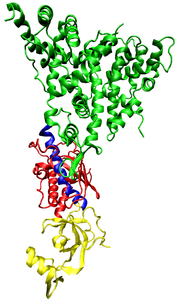
Dicer
Encyclopedia

Endoribonuclease
A Endoribonuclease is a ribonuclease endonuclease. It cleaves either single-stranded or double-stranded RNA, depending on the enzyme. Example includes both single proteins like RNase III, RNase A, RNase T1, and RNase H, and also complexes of proteins like RNase P and the RNA-induced silencing...
in the RNase III
RNase III
RNase III enzymes specifically bind to and cleave double-stranded RNA . There are three subdivisions, known as Class 1, 2, and 3.Prokaryotic ribonuclease III is an enzyme that digests double-stranded RNA. It is involved in the processing of ribosomal RNA precursors and of some mRNAs.* Class 1...
family that cleaves double-stranded RNA (dsRNA) and pre-microRNA (miRNA) into short double-stranded RNA fragments called small interfering RNA
Small interfering RNA
Small interfering RNA , sometimes known as short interfering RNA or silencing RNA, is a class of double-stranded RNA molecules, 20-25 nucleotides in length, that play a variety of roles in biology. The most notable role of siRNA is its involvement in the RNA interference pathway, where it...
(siRNA) about 20-25 nucleotide
Nucleotide
Nucleotides are molecules that, when joined together, make up the structural units of RNA and DNA. In addition, nucleotides participate in cellular signaling , and are incorporated into important cofactors of enzymatic reactions...
s long, usually with a two-base overhang on the 3' end. Dicer contains two RNase III domains and one PAZ domain; the distance between these two regions of the molecule is determined by the length and angle of the connector helix and may influence the length of the siRNAs it produces. Dicers interact with several partner proteins (TRBP in humans, R2D2, Loqs in Drosophila
Drosophila
Drosophila is a genus of small flies, belonging to the family Drosophilidae, whose members are often called "fruit flies" or more appropriately pomace flies, vinegar flies, or wine flies, a reference to the characteristic of many species to linger around overripe or rotting fruit...
). These partner proteins could play a role in dictating the substrate specificity of Dicer proteins to their substrates.
Dicer facilitates the formation of the RNA-induced silencing complex
RNA-induced silencing complex
RNA-Induced Silencing Complex, or RISC, is a multiprotein complex that incorporates one strand of a small interfering RNA or micro RNA . RISC uses the siRNA or miRNA as a template for recognizing complementary mRNA. When it finds a complementary strand, it activates RNase and cleaves the RNA...
(RISC), whose catalytic component argonaute
Argonaute
Argonaute proteins are the catalytic components of the RNA-induced silencing complex , the protein complex responsible for the gene silencing phenomenon known as RNA interference . Argonaute proteins bind different classes of small non-coding RNAs, including microRNAs , small interfering RNAs and...
is an endonuclease
Endonuclease
Endonucleases are enzymes that cleave the phosphodiester bond within a polynucleotide chain, in contrast to exonucleases, which cleave phosphodiester bonds at the end of a polynucleotide chain. Typically, a restriction site will be a palindromic sequence four to six nucleotides long. Most...
capable of degrading messenger RNA
Messenger RNA
Messenger RNA is a molecule of RNA encoding a chemical "blueprint" for a protein product. mRNA is transcribed from a DNA template, and carries coding information to the sites of protein synthesis: the ribosomes. Here, the nucleic acid polymer is translated into a polymer of amino acids: a protein...
(mRNA). The human version of this gene is DICER1
DICER1
Dicer1, Dcr-1 homolog , also known as DICER1, is a protein which in humans is encoded by the DICER1 gene. It is present in many organisms as Dicer.- Function :...
.
Dicer and other miRNA processing enzymes may be important in cancer prognosis.
History
Dicer was given its name by a graduate student in a lab at Cold Spring Harbor LaboratoryCold Spring Harbor Laboratory
The Cold Spring Harbor Laboratory is a private, non-profit institution with research programs focusing on cancer, neurobiology, plant genetics, genomics and bioinformatics. The Laboratory has a broad educational mission, including the recently established Watson School of Biological Sciences. It...
who first demonstrated the enzyme's dsRNA "dicing" activity.
In the moss Physcomitrella patens
Physcomitrella patens
Physcomitrella patens is a moss used as a model organism for studies on plant evolution, development and physiology.-Model organism:...
DCL1b, one of four DICER proteins, is not involved in miRNA biogenesis but in dicing miRNA target transcripts. Thus, a novel mechanism for regulation of gene expression
Regulation of gene expression
Gene modulation redirects here. For information on therapeutic regulation of gene expression, see therapeutic gene modulation.Regulation of gene expression includes the processes that cells and viruses use to regulate the way that the information in genes is turned into gene products...
, the epigenetic
Epigenetics
In biology, and specifically genetics, epigenetics is the study of heritable changes in gene expression or cellular phenotype caused by mechanisms other than changes in the underlying DNA sequence – hence the name epi- -genetics...
silencing of genes by miRNAs, was discovered.

